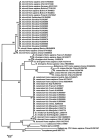Emerging Human Babesiosis with "Ground Zero" in North America
- PMID: 33672522
- PMCID: PMC7923768
- DOI: 10.3390/microorganisms9020440
Emerging Human Babesiosis with "Ground Zero" in North America
Abstract
The first case of human babesiosis was reported in the literature in 1957. The clinical disease has sporadically occurred as rare case reports in North America and Europe in the subsequent decades. Since the new millennium, especially in the last decade, many more cases have apparently appeared not only in these regions but also in Asia, South America, and Africa. More than 20,000 cases of human babesiosis have been reported in North America alone. In several cross-sectional surveys, exposure to Babesia spp. has been demonstrated within urban and rural human populations with clinical babesiosis reported in both immunocompromised and immunocompetent humans. This review serves to highlight the widespread distribution of these tick-borne pathogens in humans, their tick vectors in readily accessible environments such as parks and recreational areas, and their phylogenetic relationships.
Keywords: Babesia crassa; Babesia divergens; Babesia duncani; Babesia microti; Babesia spp.; Babesia venatorum; human babesiosis.
Conflict of interest statement
The authors declare that they have no competing interests.
Figures


References
-
- Skrabalo Z., Deanovic Z. Piroplasmosis in man; report of a case. Doc. Med. Geogr. Trop. 1957;9:11–16. - PubMed
Publication types
Grants and funding
LinkOut - more resources
Full Text Sources
Other Literature Sources
Miscellaneous

